| Article ID | Journal | Published Year | Pages | File Type |
|---|---|---|---|---|
| 3485904 | The Kaohsiung Journal of Medical Sciences | 2012 | 5 Pages |
Therapy-related acute leukemia develops in patients after chemotherapy and/or radiotherapy for a prior cancer, and most cases are acute myeloid leukemia with a much lower frequency of acute lymphoblastic leukemia (ALL). One unique feature of these therapy-related ALL (t-ALL) is an increased incidence of chromosome band 11q23 aberrations as compared with de novo ALL. In adult female patients, breast cancer is the most common primary cancer. Herein, we report the case of a 49-year-old Taiwanese lady who developed t-ALL with t(4;11)(q21;q23) 16 months after cyclophosphamide, epirubicin, and 5-fluorouracil chemotherapy for her breast cancer. The unusual feature is that the t-ALL was heralded 4 months ago by marrow lymphocytosis comprising atypical small lymphocytes with condensed chromatin mimicking a B-cell chronic lymphoproliferative disorder. Retrospective studies using additional antibodies for immunophenotyping and PCR-based clonality study for immunoglobulin gene rearrangement showed that these atypical small lymphocytes shared similar features with the leukemic blasts at the frank leukemic stage. Our results suggest that these atypical small lymphocytes are lymphoblasts in disguise and that the clinicopathological correlations with ancillary pathological studies are important to reach a definitive diagnosis of such an unusual case.
